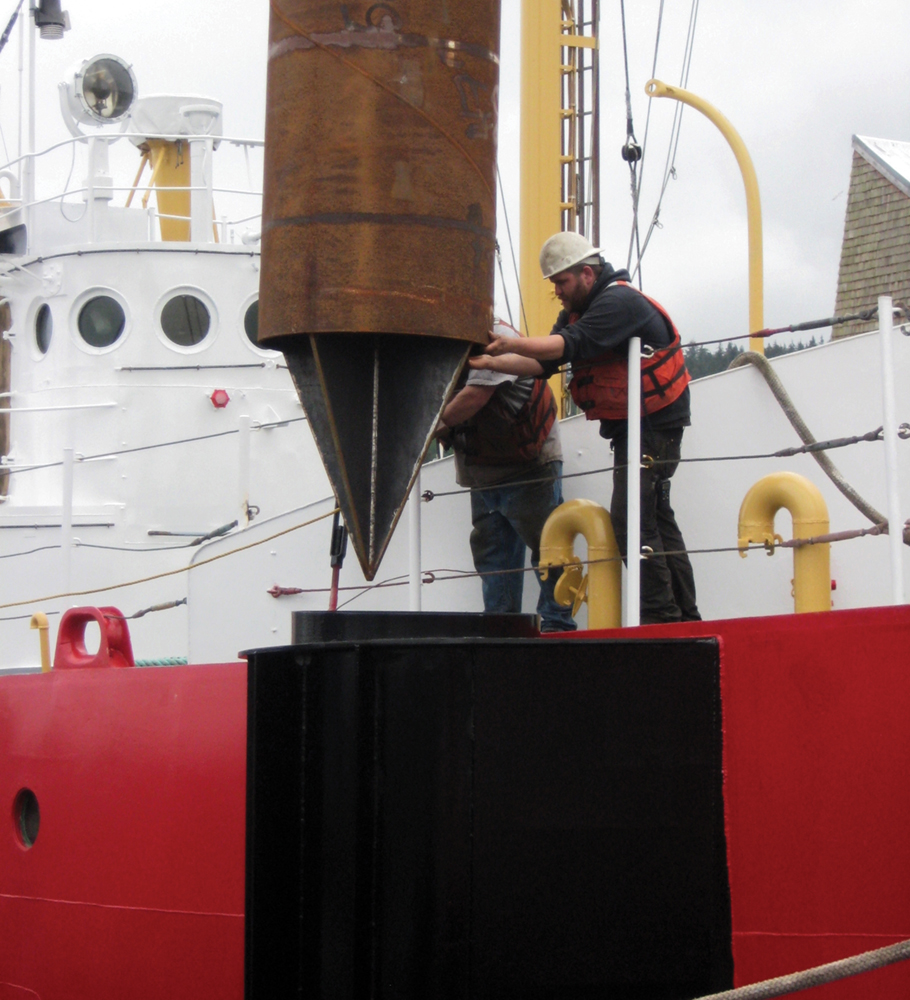
In 1872, the entrance to the Columbia River was the site of the first lightship on the West Coast. And the final lightship version, WLV-604, was the last to be retired in 1979, after 28 years of service.
When loaded with fuel and stores, the vessel’s hull resembled a 128-foot cargo vessel with a displacement of over 600 tons. Most of this was not actually cargo—the look was the result of the heavy construction to survive everything the sea could throw at it, plus tons of ballast to prevent a knockdown in storm conditions.
It was replaced by a U.S. Coast Guard Large Navigation Buoy (LNB)—a remarkable piece of engineering with a 40-foot diameter and a mast 42 feet high. It employed that decade’s latest technology, including a strobe light visible for 10 miles, fog signal and radio beacon, until it was itself retired in 1993.
However, both historic structures were saved from the scrapyard by the efforts of the Columbia River Maritime Museum (CRMM), which was founded in Astoria, Oregon in 1962.
By 2021, the LNB had been out of the water for over a decade at the Tongue Point shipyard three miles upstream, and the lightship was also overdue for a haul-out after many years in the water outside the museum.

Last October, CRMM management began its “Lightship Columbia Drydock Project” by having WLV-604 towed to Diversified Marine shipyard in Portland.
There, the 70-year-old vessel was lifted out for a complete hull maintenance schedule of inspection, cleaning and sandblasting. Ultrasound readings of the hull plate showed that the hull was in exceptionally good shape. Work continued with repair and repainting, while the ship’s many valves, fuel, ballast and water tanks were drained, cleaned and painted. The decks, superstructure, masts, fittings and rigging were all overhauled and then navigation lights replaced. LED lights were installed in light fixtures.
It was found that WLV-604 is one of only six lightships in the class built with brass pilot houses and railings, and below decks, access was created with an observation platform in the engine room above the original Atlas Imperial 8-cylinder 550 SHP direct-reversing engine.
Modern safety regulations for stationary craft required the removal of the one-ton propeller, and for the rudder welded to the stern on the centerline. The galley, messroom and other areas below deck that had never been open to the public were also restored and modified to allow access by visitors.
There was still more work to do but first, the ship was towed back to the Tongue Point shipyard where the LNB had sat neglected at the edge of the property for a decade. It was hauled under cover for a quick makeover while the lightship was berthed nearby.
The crew at WCT Marine cut the steel for a major addition to the ship that would permanently change the way the public experienced this important piece of the region’s history.
Previously, the museum had regularly been forced to close the ship during extreme high and low tides with a 10-foot tidal range at springs because of the steep angle of the boarding ramps. The unique solution was to fabricate and attach two spud boxes that fit the curved topsides fore and aft and hold the hull well away from the dockside. This required a new aluminum boarding platform to be drafted and assembled to safely span the gap.
In early June, the big buoy was towed along the waterfront by the yard’s push tug the 85-foot, 1800 hp Voyager, and into the berth, then the lightship was positioned behind it, with the yard’s 100-ton crane barge, DB Beaver, on the opposite side of the pier.
At high tide, the two 40-foot spuds were hoisted over the pier by the crane’s 165-foot boom and swiftly lowered into the spud wells in about 25 feet of water. The result of this extensive conversion can give visitors some understanding of the harsh life of lightship crews around the American coast for a century when maritime commerce was building the coastal economy and tradition.

